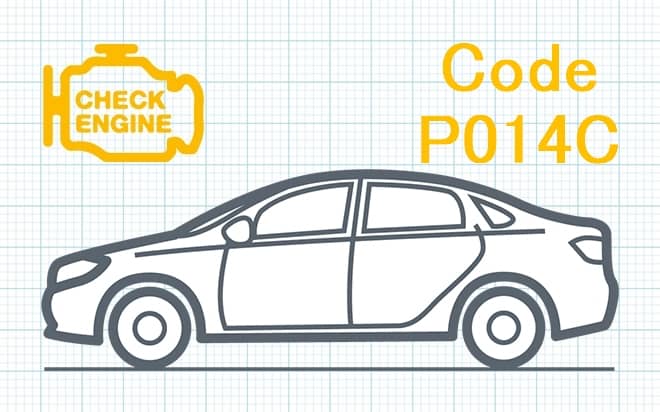
P014C O2 Sensor Slow Response - Rich to Lean (Bank 1 Sensor 1)
Content
P014C O2 Sensor Slow Response - Rich to Lean (Bank 1 Sensor 1)
OBD-II DTC Datasheet
Slow O2 Sensor Response - Rich to Lean (Bank 1 Sensor 1)
What does this mean?
This Diagnostic Trouble Code (DTC) is a generic transmission code, which means it applies to OBD-II equipped vehicles (GMC, Chevrolet, Ford, Dodge, Chrysler, VW, Toyota, Honda, etc.). Although general in nature, the specific repair steps may differ depending on the brand / model.
When a P014C code is stored in an OBD-II equipped vehicle, it means that the powertrain control module (PCM) has detected a slow response time from incoming (first after exhaust from the engine upstream of the catalytic converter) oxygen (O2) sensor or circuit for the first row engines. Bank 1 defines the engine group that contains cylinder number one.
Automotive O2 / Oxygen sensors are constructed using a zirconia sensing element that is protected by a specially designed vented steel housing. Platinum electrodes are used to attach the sensing element to the wires in the O2 sensor wiring harness, which is connected to the PCM via the Controller Network (CAN). An electrical signal is sent to the PCM according to the percentage of oxygen particles in the engine exhaust compared to the oxygen content in the ambient air.
Exhaust gases enter the exhaust manifold (s) and downpipe (s), where they flow over the O2 sensor located in front of it. Exhaust gases pass through the vents of the O2 sensor (in a steel housing) and through the sensor, while ambient air is drawn in through the wiring cavities where it is trapped in a small chamber in the center of the sensor. Trapped ambient air (in the chamber) is heated by the exhaust gases, causing oxygen ions to produce (energetic) stress.
Deviations between the concentration of oxygen molecules in the ambient air (drawn into the central cavity of the O2 sensor) and the concentration of oxygen ions in the exhaust gas cause the heated oxygen ions inside the O2 sensor to jump very quickly between the platinum layers and constantly. Voltage fluctuations occur when oxygen ions bounce between layers of platinum electrodes. These voltage changes are identified by the PCM as changes in the oxygen concentration in the exhaust gases, which indicate that the engine is running either lean (too little fuel) or rich (too much fuel). When more oxygen is present in the exhaust (lean state), the voltage signal from the O2 sensor is low and higher when less oxygen is present in the exhaust (rich state). This data is used by the PCM primarily to calculate fuel and ignition timing strategies and to monitor the efficiency of the catalytic converter.
If the O2 sensor in question is unable to operate as quickly and / or regularly as expected for a given period of time and under certain predetermined circumstances, a P014C code will be stored and a malfunction indicator lamp may come on.
Other DTCs associated with Slow O2 Sensor Response include:
- P013A O2 Sensor Slow Response – Rich to Lean (Bank 1 Sensor 2) PXNUMXA OXNUMX Sensor Slow Response – Rich to Lean (банк XNUMX, датчик XNUMX)
- P013B O2 Sensor Slow Response - Lean to Rich (Bank 1 Sensor 2)
- P013C O2 Sensor Slow Response - Rich to Lean (Bank 2 Sensor 2)
- P013D O2 Sensor Slow Response - Lean to Rich (Bank 2 Sensor 2)
- P014D O2 Sensor Slow Response - Lean to Rich (Bank 1 Sensor 1)
- P014E O2 Sensor Slow Response - Rich to Lean (Bank 2 Sensor 1)
- P014F O2 Sensor Slow Response - Lean to Rich (Bank 2 Sensor 1)
Code severity and symptoms
Since the P014C code means the O2 sensor has remained slow for a long period of time, it should be classified as serious.
Symptoms of this code may include:
- Reduced fuel efficiency
- General lack of engine power
- Other associated DTCs may also be stored.
- Service engine lamp will light up soon
reasons
Possible reasons for setting this code:
- Defective O2 sensor (s)
- Burnt, broken, or disconnected wiring and / or connectors
- Defective catalytic converter
- Engine exhaust leaks
Diagnostic and repair procedures
Some of the basic tools I will need to diagnose a P014C code are a diagnostic scanner, a digital volt/ohmmeter (DVOM), and a reliable source of vehicle information (All Data DIY).
All engine misfire codes, throttle position sensor codes, manifold air pressure codes, and MAF sensor codes must be diagnosed and repaired before attempting to diagnose the P014C code. An engine that is not running efficiently will cause all sorts of codes to be stored (and rightly so).
Professional technicians usually begin by visually inspecting the system's wiring harnesses and connectors. We focus on harnesses that are routed near hot tailpipes and manifolds, as well as those that are routed near sharp edges, such as those found on the exhaust flaps.
Search for technical service bulletins (TSB) in your vehicle information source. If you find one that matches the symptoms and codes presented on the vehicle in question, it will most likely help you in making a diagnosis. TSB lists are compiled from thousands of successful repairs.
Then I like to connect the scanner to the car diagnostic port and retrieve all stored DTCs and freeze frame data. This information can be helpful if the P014C is found to be unstable, so write it down for later. Now clear the codes and see if P014C is reset.
If the code is cleared, start the engine, allow it to reach normal operating temperature, and then let it idle (with the transmission in neutral or park). Use the scanner data stream to monitor the O2 sensor input.
Narrow down your data flow display to include only relevant data and you'll see a faster, more accurate response. If the engine is running efficiently, the upper O2 sensor reading should regularly fluctuate between 1 millivolt (100 volts) and 9 millivolts (900 volts). If the voltage fluctuation is slower than expected, P014C will be stored.
You can connect DVOM test leads to sensor ground and signal leads to monitor real-time O2 sensor data. You can also use it to test the resistance of the O2 sensor in question, as well as voltage and ground signals. To prevent damage to the control module, disconnect the appropriate controllers before testing the system circuit resistance with the DVOM.
Additional diagnostic notes:
- After the PCM has entered closed loop mode, the downstream O2 sensors should not operate as regularly as the upstream sensors.
- Replaceable (or retrofitted) poor quality catalytic converters are prone to repeated failures and should be avoided.
Related DTC discussions
- Nissan Altima codes P014C, P014D, P015A and P015BI have a check engine. I have save code P014C, P014D, P015A and P015B Nissan Altima 2016. Can you help me ...
- Re: Nissan Altima codes P014C, P014D, P015A and P015BWhat should I do to fix this? Any help would be helpful. Thanks in advance…
- Error code P014C 2016 Nissan MaximaI have a 2016 max, I had a P014C error code, I went to the dealer, they replaced 2 sensors, but I turned on the engine light again a day later, and I get the same error code even after replacing the sensors. what else could it be? Thanks…
- 2012 Ram 6.7L codes p014c p014d p0191 p2bacMy 2012 mega ram cab with 6.7 engine. Purchased in November 2016, it had 59,000 km. Ran without problems until July (71464 miles), when the chk eng indicator came on with the codes p014d p014c p0191 delivered to the dealer, they installed the wiring strip in accordance with the dodge tsb. Then there was no light for two weeks ...
Need more help with code p014c?
If you still need help with DTC P014C, post a question in the comments below this article.
NOTE. This information is provided for informational purposes only. It is not intended to be used as a repair recommendation and we are not responsible for any action you take on any vehicle. All information on this site is protected by copyright.
